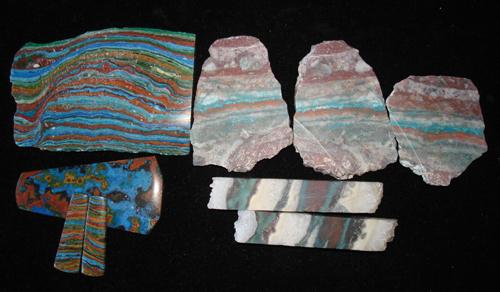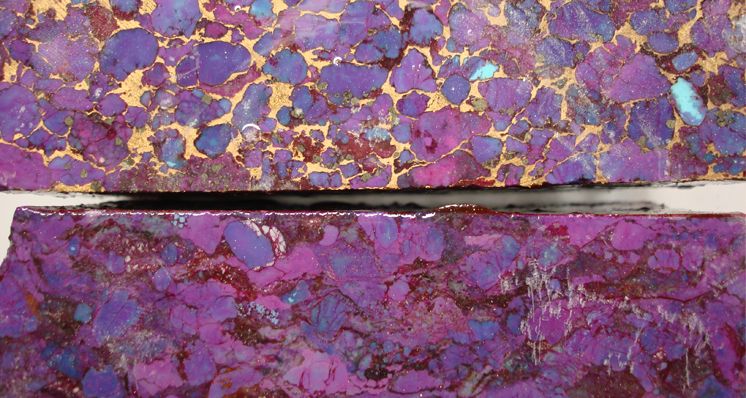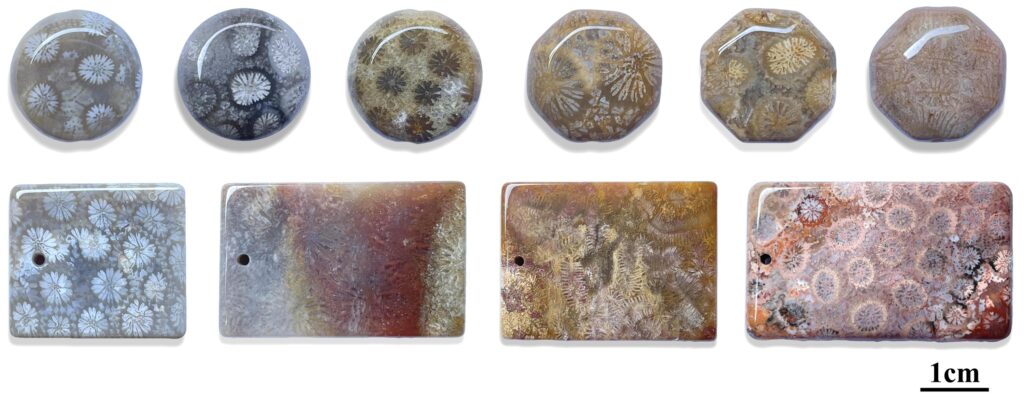Helen Serras-Herman FGA guides us through the varieties of all-natural and enhanced gem materials, highlighting key treatments and their impact on the marketplace.
There is an endless inventory of lapidary gem material on the market today, created or enhanced to look like other natural materials, usually one that is rare and expensive. Most of these enhanced materials are natural materials that have been dyed or compressed to simulate a better quality material, while some are partly natural stone and partly other materials, such as resins and metals. There are also natural materials that have been dyed to a completely different colour in order to look like another natural material, which we could call ‘look-a-likes’. All these simulants provide an inexpensive alternative to natural gems, and many of them are beautiful, with bold patterns and durability.
The only problem surrounding these stones is disclosure, or the lack of it. Dealers should always let their customers know exactly what they are buying. Even though many times the original wholesaler or lapidary may have disclosed information about the nature of the rough, cabochons or beads, somewhere down the line, or online, information gets buried or blurred.
One of the reasons for disclosure, besides honesty, is for the customer to know how to take care of the finished stones. The customer may be the lapidary, designer, metalsmith, the final jewellery client or collector. Disclosure helps determine how well stones will wear once set into jewellery, whether they should be set into rings (which take more abuse) or pendants and brooches, or how will they survive in an ultrasonic cleaning machine.


Turquoise Sky necklace made by Helen Serras Herman: The carved turquoise in this ‘Turquoise Sky’ pendant, set in sterling silver with orange sapphires from Montana, is from the Hatchita Mine in Southwestern New Mexico, showing natural beautiful golden-colour matrix inclusions.
According to the Federal Trade Commission (FTC) guides for the jewellery industry, with the exception of normal fashioning (cutting and polishing), it is the seller’s responsibility at all levels of commerce to clearly disclose to the buyer at the time of the sale whether the stone is natural or not, and about any enhancements.
While many articles focus on disclosure of enhancements of faceted rubies, emeralds or diamonds, the cabochon and bead market slides almost quietly under the disclosure radar.
NATURAL TURQUOISE VS STABILISED & COMPRESSED TURQUOISE
Turquoise is a beautiful gemstone found in several places around the world. As one by one the famous Arizona turquoise mines close – Bisbee, Sleeping Beauty – there are not too many options left to source the all-natural material, which is sought after and appreciated by lapidaries, gem collectors and jewellery lovers alike. Hard, all-natural turquoise is probably less than 3% of all turquoise sold today.
The vast majority of turquoise on the market has been stabilised with polymers in order for the stone to harden, a permanent treatment. When dyes are added to the resin, the turquoise is referred to as ‘treated’ instead of ‘stabilised’.


Blocks by Colbaugh Processing Inc. A variety of compressed natural turquoise blocks is offered by Colbaugh Processing, including turquoise with bronze, Mohave purple turquoise with and without bronze, and Mohave green turquoise with and without bronze.
A rarer form of turquoise comes in a compressed type. Small, natural nuggets of quality turquoise are compressed with resin into blocks. The outline of each nugget is still visible. There are no dyes in these blocks. These blocks are created by Colbaugh Processing Inc, a very-well known company owning the only active mine for turquoise in Arizona, the Kingman mine. They also create compressed blocks of natural turquoise nuggets infused with bronze or zinc that offer a very unique look, simulating natural turquoise with golden web inclusions. A dyed bright green turquoise block is also available, with or without infused bronze, simulating the rare bright green gaspeite from Australia.
NATURAL LAPIS VS ENHANCED VS SIMULANT
Lapis Lazuli is a striking rich blue opaque rock, composed of several minerals; lazurite, calcite veins and pyrite crystals are the most predominant. There are only a few well-known mining areas in the world producing fine quality lapis: Russia, Chile and Afghanistan, and they are all ancient deposits.


Pale and mottled material is successfully marketed as ‘Denim lapis’. Lapis should be kept away from heat and chemicals, especially in the event that the stones, carvings or beads may be dyed. Simulants include a brightly-coloured man-made lapis crushed for inlays, and magnesite from China, a soft and porous material, dyed blue with added metallic inclusions that simulate pyrite, that truly looks like natural lapis.
RAINBOW CALSILICA
Rainbow Calsilica is a manufactured material created and sold by Colbaugh Processing Inc. The material imitates natural quartz with veins of blue chrysocolla and red jasper found in copper mines in Arizona. This colour combination is rare making the natural pieces highly prized.


Rainbow Calsilica, man-made (left) vs. natural (right): Rainbow Calsilica is a manufactured material made of pulverised calcite mixed with pigments and stabilised with a polymer, imitating quartz with veins of blue chrysocolla and red jasper.
Tests were undertaken on samples of Rainbow Calsilica at the SSEF Swiss Gemmological Institute laboratory in Basel in 2002. Their final report, as referenced in the GIA’s Gems & Gemmology magazine in 2002, states that “the samples examined appear to have been made of pulverized carbonate rock (calcite) mixed with pigments and stabilised with a polymer.”
CONCLUSION
As lapidaries, designers and collectors, we always look for new gem materials to incorporate into our artwork. The list of all natural materials is shrinking daily, and the variety of enhanced lapidary materials on the market today is almost overwhelming.
The better we understand these materials, the better we will be able to sell them to our customers. Today’s gem and jewellery consumers are educated, and look up to artists and jewellers to alert them about the natural origin of the materials or the technological enhancements that made these lapidary gem materials available, affordable, durable and appealing. ■
Gem-A members can log in to read the full article Gems&Jewellery Spring 2017 / Volume 26 / No. 1
Interested in finding out more about gemmology? Sign-up to one of Gem-A’s courses or workshops.
If you would like to subscribe to Gems&Jewellery and The Journal of Gemmology please visit Membership.
Cover image Mohave purple turquoise blocks: Mohave purple turquoise has become very popular and is made from natural turquoise compressed with resin, then dyed and stabilised. All images by Hellen Serras-Herman.
{module Blog Articles Widget}



